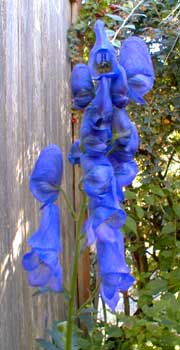
Arends's Turk's Cap
"Lowly pansies set in flocks
With purple monkshood overawed."
Duncan Campbell Scott,
1862‚1947
1862‚1947
Acontinum x. arendsii aka A. carmichaelii 'Arendsii' is the most thickly-stemmed of our monkshood varieties & species, for which reason it usually does not require staking for many years, though a very old clump can get sufficiently topheavy with blossoms that it may someday want at least a fence to lean against. At around three to four feet of height, it is among the shortest & stoutest of all monkshoods, though some specimens do get taller, especially if in deep shade. Also, the deep sea-green leaves are larger & leatherier than on most aconites. It has an overall tougher appearance than other monkshoods.
Despite monkshood toxicity, they're in general safely handled, & increasingly popular for bouquets. 'Arendsii' follows distantly behind A. napellus as the second most important monkshood for florists & in cut flower production. A napellus dominates the earlier & longer cut flower season, & 'Arendsii' extends the flower-type's availability to October. Vase life is a week to ten days. It is also possible to dry the flowers, though their toxicity will not decline from drying.
The photo here was taken in September (2003) at the end of this clump's first year in our garden, in partial shade along the wooden fence. As one of the latest bloomers, with shimmering amethyst flowers, 'Arendsii' & its species generally (see A. charmichaeli) is the best choice for keeping monkshood blooms in the garden very late in the year.
It buds all along the flower stems, in full flower first at the very top, with green buds lower on the stems forming new blooms quite some while, in some cases right up to the start of November.
Ideal for zones 3 through 7, it can be stretched for zones 2 through 9, being especially cold-adaptable. It will tolerate full sun, though not heat tolerant & will need more shade the further south it is grown. Dappled sunlight or partial shade in moist cool well-draining soil is generally its ideal.
The variety is named for the Nineteenth Century plant breeder Georg Arends (1862-1952) of Ronsdorf, Germany, best remembered for his Astilbe introductions. Arends introduced this standard garden monkshood late in his long career, in 1945.
It is essential to educate children about any such plants as monkshood growing in your garden. Seriously toxic plants should perhaps not be planted at all if there are going to be unsupervised toddlers in the gardens, such as do occasionaly decide bright flowers look like candy & eat them. But mild paranoia about such danger would seem to be sufficient, as when I tried to track down examples of monkshood accidents injuring children or pets because they are so popularly gardened, I could find not even an unusual rare case, even though there are many cases of death from intentional use of aconite roots as dangerous medicines or for purposes of assassination.
Aconitum lamarckii, Yellow Monkshood